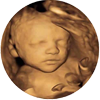As you approach the later stages of pregnancy, you might start to wonder about your baby’s position. One of the most important aspects of your baby’s positioning is whether their head is down, as this can play a significant role in the birth process. The NHS provides helpful advice to understand how to determine if your baby is in this ideal position. Here’s what you need to know.
Why is the Baby’s Position Important?
In most cases, the baby being head-down (known as the cephalic position) by around 36 weeks is optimal for a straightforward vaginal birth. A head-down baby is positioned to navigate the birth canal effectively, reducing the likelihood of complications during labour.
Babies can adopt a range of other positions, such as breech (bottom-down) or transverse (lying sideways), which may require different considerations for delivery.
How Can You Tell If Your Baby is Head Down?
While your midwife or GP is the best person to confirm your baby’s position, there are signs you can look for at home. According to NHS advice:
Movement Patterns: If your baby’s head is down, you might feel stronger, more noticeable kicks higher up near your ribs. Lighter movements or fluttering may be felt lower in your pelvis, which could indicate your baby’s hands or elbows moving.
Pressure in the Pelvis: As the baby’s head moves down, you may experience increased pressure in your pelvic region. This can feel like a heaviness or a sensation of the baby “dropping.”
Shape of Your Bump: A head-down baby may cause your bump to appear lower, especially in the later stages of pregnancy.
Hiccups: Feeling rhythmic, pulsing movements low in your abdomen could suggest that your baby’s chest (and not their head) is positioned lower, meaning their head is likely down.
Professional Confirmation
At your antenatal appointments, your midwife will check your baby’s position by feeling your abdomen in a procedure called abdominal palpation. They may also listen to the baby’s heartbeat with a Doppler or Pinard stethoscope, which can provide further clues about positioning.
If there’s any uncertainty about your baby’s position, the midwife may arrange an ultrasound scan for confirmation.
What If Your Baby Isn’t Head Down?
If your baby isn’t head-down by 36 weeks, don’t panic. Babies can sometimes turn on their own, even late in pregnancy. If this doesn’t happen, the NHS might recommend an External Cephalic Version (ECV), a procedure where a healthcare provider gently tries to turn the baby from the outside.
If an ECV isn’t successful, your healthcare team will discuss other options for delivery, such as a planned caesarean section.
When to Seek Advice
It’s essential to stay in close contact with your midwife, especially if you’re unsure about your baby’s position or experiencing unusual discomfort. Regular antenatal appointments are key to ensuring you and your baby remain healthy throughout pregnancy.
Final Thoughts
Understanding your baby’s position is an exciting part of preparing for childbirth. By tuning into your body and seeking regular check-ups, you can stay informed about your baby’s positioning and ensure you’re well-prepared for the delivery. For personalised advice, always consult your midwife or GP—they are there to support you every step of the way.













 Packages & Prices
Packages & Prices  Important Info & Policies
Important Info & Policies  Your Scan
Your Scan